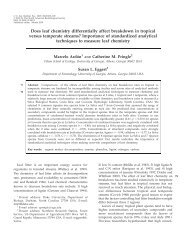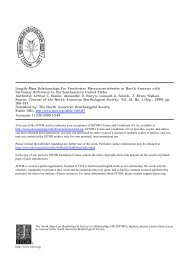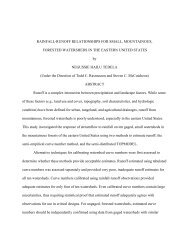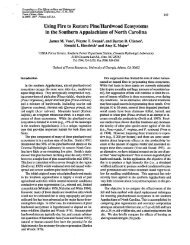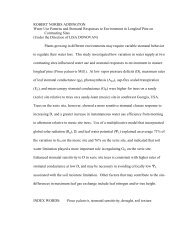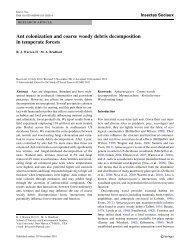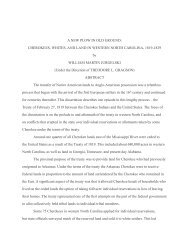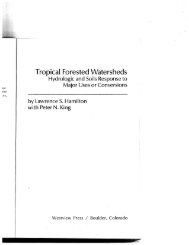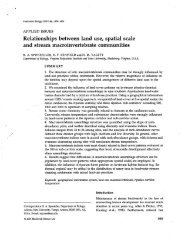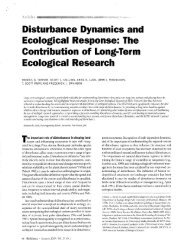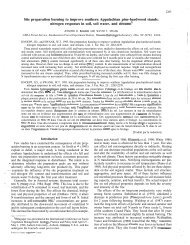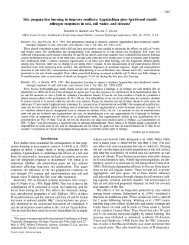biology join - Coweeta LTER - University of Georgia
biology join - Coweeta LTER - University of Georgia
biology join - Coweeta LTER - University of Georgia
Create successful ePaper yourself
Turn your PDF publications into a flip-book with our unique Google optimized e-Paper software.
Articles<br />
Ecoregions<br />
Subarctic<br />
tundra<br />
Arctic tundra<br />
Boreal forest<br />
Coastal rainforest<br />
on Rural Alaska Self-Reliance, a collaboration to implement<br />
community visions <strong>of</strong> adaptation to global change. This collaboration<br />
suggests that indigenous leaders value and trust<br />
their interactions with Bonanza Creek scientists.<br />
Discussion <strong>of</strong> the case studies. Boundary-spanning efforts can<br />
facilitate the bridging <strong>of</strong> science and society by producing<br />
information that is salient, credible, and legitimate (Cash<br />
et al. 2003, McNie et al. 2008), which ultimately enriches<br />
scientific research through stakeholder engagement, the<br />
expansion <strong>of</strong> public awareness, and the improvement <strong>of</strong><br />
the scientific basis for decisionmaking. The five <strong>LTER</strong> case<br />
studies presented here <strong>of</strong>fer experiences and lessons to help<br />
answer the question <strong>of</strong> what characterizes successful collaborative<br />
outreach efforts. The case studies suggest that<br />
efforts to build a stronger interface between science and<br />
society are shaped in part by three overarching attributes<br />
that pertain to all ecosystems but vary in detail among<br />
ecosystems: (1) Landscape and social context refers to the<br />
pattern <strong>of</strong> land ownership (e.g., private versus public) and<br />
the role <strong>of</strong> the different types <strong>of</strong> knowledge (e.g., local versus<br />
expert) that influence the framing <strong>of</strong> environmental issues,<br />
the management objectives, and the science used in the<br />
decisionmaking process. (2) Issue definition involves<br />
Indigenous Languages and Peoples<br />
Central Yup'ik<br />
Deg Xinag<br />
Eyak–Tlingit<br />
Tlingit<br />
determining the relevance <strong>of</strong> particular long-term research to<br />
policy and management issues at local, regional, or national<br />
scales (e.g., local fire- or fuel-management issues, regional<br />
air-quality concerns, federal forestland policy) and the extent<br />
to which individual actions or government actions are central<br />
to resolving the issues <strong>of</strong> concern. (3) Communication<br />
pathways entail understanding which communication approaches<br />
are most appropriate for specific decisionmakers,<br />
and the choice <strong>of</strong> pathway is determined in part by the<br />
context and issues addressed (e.g., direct briefings between<br />
scientists and policymakers; outreach to the media; working<br />
groups with managers; discussions with local communities,<br />
including tribes).<br />
In addition to these three overarching attributes that<br />
distinguish individual efforts, a set <strong>of</strong> common elements <strong>of</strong><br />
successful science communication efforts emerges from the<br />
case studies:<br />
In all <strong>of</strong> the case studies, boundary-spanning efforts were<br />
built on credible, multidecade, interdisciplinary science, and<br />
peer-reviewed publications. These efforts combine retrospective<br />
analysis; long-term measurements and experiments;<br />
quantitative modeling; and, increasingly, scenarios planning.<br />
For example, the ability <strong>of</strong> the HBRF Science Links projects<br />
to assess the impacts <strong>of</strong> air-quality regulations and the extent<br />
362 BioScience • April 2012 / Vol. 62 No. 4 www.biosciencemag.org<br />
Ahtna<br />
Eyak<br />
Haida<br />
Tsimshian<br />
Eskimo–Aleut Athabascan<br />
Iñupiaq<br />
Gwich'in Holikachuk<br />
Unanga{ (Aleut)<br />
Sugpiaq (Alutiiq) Dena'ina Tanacross<br />
St. Lawrence Island Yupik<br />
Hän<br />
Upper Kuskokwim<br />
Upper Tanana<br />
Lower Tanana<br />
Denaakk'e<br />
(Koyukon)<br />
Map by C. West, M. Wilson and J. Kerr - ISER<br />
Figure 5. Cultural (linguistic) groups and ecoregions are closely coupled in the boreal forest region <strong>of</strong> Alaska (Chapin<br />
2009). The Bonanza Creek Long Term Ecological Research Network site uses understanding <strong>of</strong> socioecological responses<br />
to climate change as a platform for exploring and implementing adaptation options that rural Athabascan communities<br />
would find consistent with their history and current commitment to sustainable subsistence lifestyles. Source: Reprinted<br />
from F. Stuart Chapin III, “Managing ecosystems sustainably: The key role <strong>of</strong> resilience.” Pages 29–53 in Chapin FS III,<br />
K<strong>of</strong>inas GP, Folke C, eds. Principles <strong>of</strong> Ecosystem Stewardship: Resilience-Based Natural Resource Management in a<br />
Changing World (2009), with permission from Springer.



